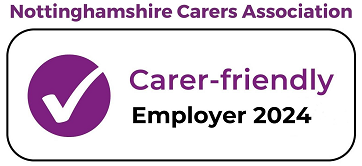What is driving us to do better
We run services from three sites (King’s Mill Hospital, Mansfield Community Hospital, Newark Hospital) and in the community.
We have five clinical divisions and a corporate division (Strategy and Partnership, People, Finance, Nursing, Medical, Governance and Operations).
Our Council of 22 Governors is elected by our members and represents our patients, local communities and our people.
As a foundation trust, we are a membership organisation. We have 14,000 members, made up of patients, local residents, our people and partners.
- We employ 6,000 people.
- We have a vibrant community of 400 volunteers.
- We spend over £500 million each year to provide healthcare to our local population.
- We serve a population of 350,000 people in Mid-Nottinghamshire and beyond.
- We have over 650 beds.
- We prepare 630,000 meals for patients every year.
- We provide 450,000 outpatient appointments every year.
- We have 190,000 emergency department and urgent care attendees every year.
- We perform 30,000 scans every year.
- We deliver 3,500 babies each year at our hospital.
- We have achieved the UNICEF Baby Friendly bronze award.
- We have achieved the Pathway to Excellence designation, a globally recognised nursing excellence framework.
- We recruited 12 people from our local area through 'Step into the NHS' careers events.
- We achieved the gold standard Veterans Aware accreditation.
- We have planted over 200 fruit trees in our Hope Orchard and more in local community orchards in Warsop and Mansfield.
What is driving us to do better?
In preparing this strategy, we examined the internal and external driving forces that must be considered in our future planning. In this section we set out how the population we serve is changing and the implications for healthcare needs, new NHS policy and what that means for us and feedback from our people and communities about the improvements they would like to see.
Consistently outstanding care provision
We do well in many areas, as supported by our good and outstanding CQC ratings. We also know that there are opportunities for further improvement. We have a collective drive to do better and deliver consistently outstanding care. We know we must learn lessons from when things go wrong and to proactively reduce the risk of them happening here at Sherwood Forest Hospitals.
Our compassionate people
Many health professions are facing a national shortage of staff, leaving some of our services challenged in the delivery of consistent care. We will continue to shape and align our services and train our people to gain alternative skill sets to deliver the best care for our local communities.
We know nationally there are not enough training places to meet our upcoming workforce shortages and so we are driven to identify new ways of working alongside our partners in health, care and education.
Health inequalities, healthier communities and use of health services
Demand for our services continues to grow. Our population is increasing in age, fragility and more people have two or more health conditions requiring more complex care. A significant proportion of our population live in areas of high deprivation and suffer from health inequalities. We also see more younger people requiring hospital care to manage their health conditions.
Over the next eight years, the number of people over 65 years of age with moderate or severe frailty is predicted to increase by 25%. For those living in our most deprived areas 50% will have moderate or severe frailty which is three times greater than those living in the least deprived areas.
The onset of frailty occurs at a much earlier age in those with deprivation; in the 50-54 age group 34% are living with frailty, which is equivalent to the 65-69 age group in least deprived areas. This has significant consequences; not only is their life expectancy shortened, but those in the most deprived areas experience a much longer period of poor health before they die (26 years compared to 15 years for those least deprived).
Social isolation and living with two or more conditions are key factors in frailty. A failure to meet the health and care needs of those living in the most deprivation fuels the unrelenting rise in urgent care demand we are experiencing.
For those who die before reaching the expected age, cardiovascular disease, cancer and respiratory illness account for 65% of deaths, with smoking, obesity and high blood pressure as key contributors. Heart attacks, stroke, cancer, chronic lung disease, arthritis and dementia are major causes of ill health with obesity, alcohol and diabetes significant contributors.
Continuously learn and improve
Our people often feel empowered to deliver continuous improvement. We can develop this further culturally across our organisation and
ensure we co-design services with the people who use them.
We must adopt innovations and technology where they provide us with opportunities to deliver improvements and efficiencies in response to the increased demand and complexity of healthcare conditions in our citizens.
The NHS impact self-assessment will also provide the underpinning framework in our improvement strategy.
Sustainable use of resources and estate
We have high quality buildings compared to many other hospitals but we will not have enough space to safely deliver the predicted growth in demand.
Due to the growing demand for our services and increasing complexity of clinical need, our finances are stretched and capital investment (in our buildings and equipment) remains challenged.
We will work with our partners across the local area to identify better local places and pathways to deliver care that also supports outstanding delivery closer to home.
Responding to the climate emergency is an aim as we work towards NHS Net Zero by 2040. Our climate action team have made significant progress already in reducing our emissions and are passionate in making sure everybody feels they too can contribute to making a difference.
We know poor air quality impacts long term conditions and affects our most deprived local areas more than the least deprived. We will continue to be driven to work with our local population and our partners to continue this work.
Working with our partners
We are not alone in the challenges we face and the drivers of why we want to develop our services. Working collaboratively with our local partners gives us greater opportunities to successfully achieve our objectives. Collaborative working supports quality, sustainable, efficient services and positively impacts on the lives of our local population.
Population health management
Population health management is an important focus as health and care needs are changing and behaviours may increase the risk of preventable disease. As we live longer, the risk of living with multiple long-term conditions, like asthma, diabetes and heart disease, increases.
The gap between living longer in good health versus poor health is widening, with the effects of Covid-19 still to be fully realised.
Taking a population health management approach to future healthcare delivery will be a key to our success. Sherwood Forest Hospitals’ role in population health is to understand the health needs now and in the future of our local communities in Mid Nottinghamshire and to work with our partners to reduce inequalities.
As an anchor organisation we can positively impact on the wider issues that support health and wellbeing of the local population, our people and our patients. We will make positive contributions to the wider determinants of health and wellbeing such as housing, employment and education.
Significant numbers of our people and their families work and live in our area of healthcare provision and we have an ambition to support living a longer healthier life.
We know that a one-size-fits-all approach to delivering healthcare is an outdated model that we seek to improve over the course of this strategy. Our strategy will also focus on designing more joined up and sustainable health and care services along with making better use of public resources. We will equip our people with the skills and experience to deliver modern healthcare treatment that provides an outstanding experience for our patients.
Mid Nottinghamshire is more deprived overall than the England average, with a higher proportion of people aged 65 years and over and more people reporting a long-term illness or disability and poor health.
The period of life people have before illness or disability is lower overall in Mid Nottinghamshire than other areas of the county. The prevalence of major illness such as diabetes, respiratory illness, heart failure, dementia, asthma and stroke and use of tobacco and alcohol is also higher than the England average but it is not equally distributed across all Mid Notts areas.
Working with our partners to reduce health inequalities, focus on prevention and improve the amount of time our population lives a healthy life is our ambition. We will take a targeted approach across our local population to better support health outcomes. Our clinical services strategy will set out our approach to targeted interventions.
In Mid Nottinghamshire 28% of the population are living in the most deprived areas of England (defined as in the most deprived 20%. Source eHS Profile Tool, N&N ICB SAIU).
Mid Nottinghamshire is made up of Ashfield, Mansfield, Newark and Sherwood and the level of deprivation is not spread equally, as shown below:
• Ashfield - 26.9%
• Mansfield - 41%
• Newark and Sherwood - 14.6%
The 2019 Indices of Multiple Deprivation (IMD) score for Mid Notts is 24.6% which is 2.9% more deprived against an England average of 21.7%.
The Mid Nottinghamshire population is older than the England average and getting older.
• 20.1% are aged 65+ versus England average of 18.6%.
Of those people with a known electronic frailty index (eFI) score:
• Mild frailty is estimated to be 30%
• Moderate frailty at 17% and
• Severe frailty at 12%
The estimated growth in those aged over 65 years over the next five years is over 10% (ONS 2018 Population projections) with:
• 21% aged over 65 years living within the most deprived areas. The number of people aged over 65 years in Mid Nottinghamshire has increased by 15.6% since 2011.





